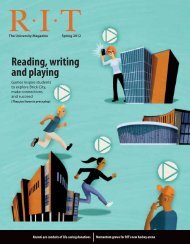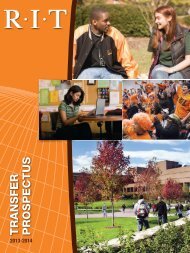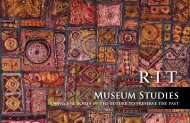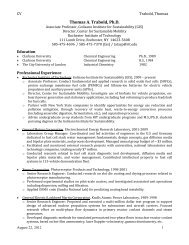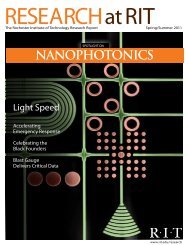Fall / Winter 2012 - Rochester Institute of Technology
Fall / Winter 2012 - Rochester Institute of Technology
Fall / Winter 2012 - Rochester Institute of Technology
Create successful ePaper yourself
Turn your PDF publications into a flip-book with our unique Google optimized e-Paper software.
Focus Area | Human-Centered Computing<br />
Modeling Sight: Eye-tracking technology recorded the eye movements <strong>of</strong> dermatology experts and students, noting where they lingered on an image and the<br />
path the eyes took as they moved across a scene. These visual Areas <strong>of</strong> Interest (AOI) have been shown to accurately illustrate a user’s cognitive process.<br />
Utilizing Computational Linguistics: Team member Cecilia Alm mines the physicians’ spoken explanations to their students to characterize meaningful<br />
language behaviors common in the dermatology community. She is developing a linguistic model, which will be incorporated into the CBIR system.<br />
Haake says. “In other words, we can<br />
make CBIR decisions more ‘human.’”<br />
Modeling Sight and Language<br />
The team, with the assistance <strong>of</strong> undergraduate<br />
and graduate students in imaging<br />
science and computing and information<br />
sciences, utilized a remote, video-based<br />
eye-tracking system to discover what<br />
dermatologists found perceptually important<br />
about images. Sixteen dermatologists<br />
viewed skin conditions in 50 different<br />
images displayed on a monitor as they<br />
explained their diagnoses to physician<br />
assistant students. A device recorded the<br />
participants’ eye movements as they<br />
lingered on the critical regions in each<br />
image. These data points, referred to as<br />
visual Areas <strong>of</strong> Interest (AOIs), have been<br />
shown to provide more objective evaluations<br />
<strong>of</strong> images and reveal the users’<br />
cognitive processing.<br />
The eye-tracking data was also used to<br />
compare how different physicians<br />
analyzed the images, based on expertise,<br />
color, contrast, size, shape, and visual versus<br />
verbalized conceptual characteristics.<br />
Preliminary results indicate that<br />
participants made their decisions based<br />
on perceptual information from multiple<br />
relevant regions in the image and people<br />
with comparable expertise had similar<br />
eye movement patterns. Pelz, co-director<br />
<strong>of</strong> the Multidisciplinary Vision Research<br />
Laboratory, says this will enhance the<br />
development <strong>of</strong> workable probabilistic<br />
models because it shows there is a<br />
correlation between domain knowledge<br />
and image perception.<br />
“By categorizing the AOIs and perception<br />
differences between participants,<br />
we can create a set <strong>of</strong> common markers<br />
that can better inform how images are<br />
categorized and retrieved,” he adds.<br />
“This will ultimately allow the CBIR<br />
system to ‘perceive’ the images in the<br />
same way they are perceived by the<br />
dermatologists using the system.”<br />
In addition to the eye-tracking data<br />
collection, team member Cecilia Ovesdotter<br />
Alm, a linguist and visiting<br />
assistant pr<strong>of</strong>essor <strong>of</strong> English at RIT, is<br />
utilizing the interactions between the<br />
experts and their students during the<br />
sessions to develop a computational<br />
linguistics model related to the image<br />
analysis. Alm is mining the physicians’<br />
spoken explanations to characterize<br />
meaningful language behaviors<br />
commonly used in the dermatology<br />
community. This linguistic model will<br />
be incorporated into the CBIR system.<br />
Alm says, “By fusing data from different<br />
sources we can create a more robust<br />
system built on the end-user’s knowledge.”<br />
The team hopes the data collected<br />
will enhance general research into visual<br />
perception and linguistics, providing<br />
additional insights on how the brain<br />
Research at RIT<br />
5





